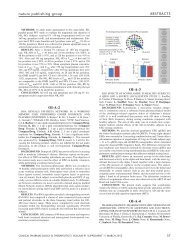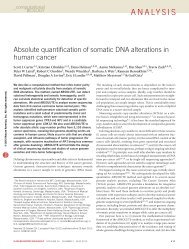open access: Nature Reviews: Key Advances in Medicine
open access: Nature Reviews: Key Advances in Medicine
open access: Nature Reviews: Key Advances in Medicine
You also want an ePaper? Increase the reach of your titles
YUMPU automatically turns print PDFs into web optimized ePapers that Google loves.
5. Alexander, J. H. et al. Apixaban with antiplatelet<br />
therapy after acute coronary syndrome. N. Engl.<br />
J. Med. 365, 699–708 (2011).<br />
6. Mega, J. L. et al. Rivaroxaban <strong>in</strong> patients with<br />
a recent acute coronary syndrome. N. Engl.<br />
J. Med. http://dx.doi.org/10.1056/<br />
NEJMoa1112277.<br />
7. Tricoci, P. et al. Thromb<strong>in</strong>-receptor antagonist<br />
vorapaxar <strong>in</strong> acute coronary syndromes.<br />
ATRIAL FIBRILLATION IN 2011<br />
Stroke prevention <strong>in</strong> AF<br />
Gregory Y. H. Lip<br />
In 2011, key trials with oral factor Xa <strong>in</strong>hibitors <strong>in</strong> patients with atrial<br />
fibrillation highlighted promis<strong>in</strong>g data on these novel anticoagulants.<br />
Patients with ≥1 stroke risk factors can be considered for oral<br />
anticoagulation. These novel, fixed-dose drugs are given without<br />
monitor<strong>in</strong>g, so cl<strong>in</strong>icians must learn to balance stroke and bleed<strong>in</strong>g risks.<br />
Lip, G. Y. H. Nat. Rev. Cardiol. 9, 71–73 (2012); published onl<strong>in</strong>e 20 December 2011;<br />
doi:10.1038/nrcardio.2011.203<br />
The year 2011 saw the publication of three<br />
pivotal phase III trials for two oral direct<br />
factor Xa <strong>in</strong>hibitors, apixaban and rivaroxaban,<br />
1–3 as well as important articles on bleed<strong>in</strong>g<br />
risk assessment 4 and the net cl<strong>in</strong>ical<br />
benefit of thromboprophylaxis. 5 Novel oral<br />
anticoagulants that are viable alternatives to<br />
warfar<strong>in</strong> have clearly changed the landscape<br />
of stroke prevention <strong>in</strong> patients with atrial<br />
fibrillation (AF). 6 Until recently, the recommended<br />
approach was artificially to stratify<br />
patients with AF <strong>in</strong>to low, <strong>in</strong>termediate, and<br />
high risk strata—despite stroke risk be<strong>in</strong>g a<br />
cont<strong>in</strong>uum—so that those classed as be<strong>in</strong>g<br />
at high risk could be targeted for an <strong>in</strong>convenient<br />
(and potentially dangerous) drug,<br />
warfar<strong>in</strong>. Many studies, however, have shown<br />
that the categorization of patients <strong>in</strong>to low,<br />
<strong>in</strong>termediate, or high risk strata has poor<br />
correlation with actual warfar<strong>in</strong> prescrib<strong>in</strong>g,<br />
and that the predictive value of risk<br />
schemes such as the CHADS 2 score (Box 1)<br />
to identify high-risk patients is suboptimal. 7<br />
Consequently, guidel<strong>in</strong>es now recommended<br />
the use of the CHA 2 DS 2 -VASc score (Box 1)<br />
to complement the older (but simpler)<br />
CHADS 2 score.<br />
Indeed, emphasis is now directed towards<br />
identification of ‘truly low-risk’ patients with<br />
AF by be<strong>in</strong>g more <strong>in</strong>clusive (rather than<br />
exclusive) of common risk factors for stroke,<br />
because these patients might not need any<br />
antithrombotic therapy. Meanwhile, patients<br />
with ≥1 risk factor for stroke should be considered<br />
for effective stroke prevention with<br />
oral anticoagulation, whether with (very)<br />
well-controlled warfar<strong>in</strong> or one of the<br />
N. Engl. J. Med. http://dx.doi.org/10.1056/<br />
NEJMoa1109719.<br />
8. Mathews, R. et al. In-hospital major<br />
bleed<strong>in</strong>g dur<strong>in</strong>g ST-elevation and<br />
non-ST-elevation myocardial <strong>in</strong>farction care:<br />
derivation and validation of a model from<br />
the ACTION Registry®-GWTG.<br />
Am. J. Cardiol. 107, 1136–1143<br />
(2011).<br />
novel agents, either an oral direct thromb<strong>in</strong><br />
<strong>in</strong>hibitor (such as dabigatran) or an<br />
oral direct factor Xa <strong>in</strong>hibitor (for example,<br />
rivaroxaban or apixaban). 1 Indeed, the<br />
CHA 2 DS 2 -VASc score has consistently been<br />
shown to outperform the CHADS 2 score<br />
<strong>in</strong> identification of truly low-risk patients<br />
and is as good as—and possibly better<br />
than—the CHADS 2 score <strong>in</strong> the identification<br />
of high-risk patients who subsequently<br />
suffer thromboembolism. 7,8<br />
<strong>Key</strong> advances<br />
■ In the AVERROES trial, apixaban was<br />
superior to aspir<strong>in</strong> for stroke prevention<br />
<strong>in</strong> patients with atrial fibrillation (AF),<br />
with similar rates of major bleed<strong>in</strong>g and<br />
improved tolerability 1<br />
■ In the ARISTOTLE trial, apixaban was<br />
superior to warfar<strong>in</strong> for prevention of<br />
stroke and systemic embolism <strong>in</strong> patients<br />
with AF, with significantly less major<br />
bleed<strong>in</strong>g and improved survival 2<br />
■ In the ROCKET-AF trial, rivaroxaban was<br />
non<strong>in</strong>ferior to warfar<strong>in</strong> for stroke prevention<br />
<strong>in</strong> a high-risk population of patients with<br />
AF, with similar rates of major bleed<strong>in</strong>g 3<br />
■ The HAS-BLED score is well validated<br />
to predict major-bleed<strong>in</strong>g events <strong>in</strong><br />
patients receiv<strong>in</strong>g anticoagulation therapy,<br />
and outperforms other bleed<strong>in</strong>g risk<br />
assessment schemes 4<br />
■ ‘Truly low-risk’ patients with a<br />
CHA 2 DS 2 -VASc score of 0 do not<br />
require thromboprophylaxis; net cl<strong>in</strong>ical<br />
benefit is greatest <strong>in</strong> patients with a high<br />
HAS-BLED score, where reduced ischemicstroke<br />
risk outweighs the <strong>in</strong>creased<br />
<strong>in</strong>tracranial-bleed<strong>in</strong>g risk 5<br />
CARDIOLOGY<br />
Attention has also been directed to assessment<br />
of bleed<strong>in</strong>g risk. Common risk factors<br />
for bleed<strong>in</strong>g (as well as potentially correctable<br />
risk factors, such as uncontrolled blood pressure<br />
and concomitant aspir<strong>in</strong> use <strong>in</strong> patients<br />
receiv<strong>in</strong>g anticoagulation therapy) can<br />
<strong>in</strong>form cl<strong>in</strong>ical decision- mak<strong>in</strong>g, especially<br />
with the novel oral anticoagulants that can<br />
come <strong>in</strong> high-dose and low-dose regimens. 9<br />
Investigators <strong>in</strong> the AVERROES trial 1<br />
studied 5,599 patients with AF and ≥1 risk<br />
factor for stroke, and who had refused warfar<strong>in</strong><br />
or been deemed unsuitable for war far<strong>in</strong><br />
by the <strong>in</strong>vestigators on the basis of the <strong>in</strong>clusion<br />
criteria. The trial was stopped early<br />
because of the clear superiority of apixaban<br />
over aspir<strong>in</strong>, with a 55% reduction <strong>in</strong> the<br />
primary end po<strong>in</strong>t of stroke and systemic<br />
embolism (HR 0.45, 95% CI 0.32–0.62,<br />
P








